Investing in real estate is one of the best ways to increase your cashflow, build equity for your future, and secure the personal and financial freedoms that traditional jobs don’t often allow.
For most real estate investors, single-family properties are the obvious starting point. And, for many, that may be the strategy that carries them through their entire career.
But, if you’ve ever had even the faintest interest in pursuing commercial/multi-family investing, this is also a great way to level up your business, diversify your portfolio, and create additional cashflow.
Take, for instance, the story of Doug Shelton. Doug got his start in the world of real estate by working as a corporate mortgage lender. While he did well in his career, the long days of being stuck in a cubicle lost their appeal quickly. That’s when Doug decided to make the leap to real estate investing.
Currently, Doug is the owner of Lease Purchase Ohio. He has also done more than 70 single-family flips in the greater Cleveland market, as well as a few other areas of Ohio. He’s also in the process of actively leveling up his business from single family rentals and rehabs to commercial and multi-family real estate.
Making the switch from single- to multi-family properties doesn’t have to be complicated, Doug says, but it does take plenty of research, hard work, and a clearly defined strategy to succeed.
If you’re already investing in single-family properties, you have the basics you need to thrive in the commercial realm. But, as I discussed with Doug, there are at least two distinct differences between single- and multi-family investing. 1) Raising private capital becomes much more essential with commercial properties and 2) Finding property deals can be more of a challenge (as compared to single-family homes), and may require some different techniques.
RAISING PRIVATE CAPITAL
When it comes to raising private capital to fund his deals, Doug has some unique strategies for finding investors. Often, instead of asking someone directly if they’d like to invest in one of his deals, he’ll position the question as, “Do you know of anyone who may have some equity who might be interested in growing their wealth through real estate investing?”
Usually, as Doug has found, the person he’s speaking to will think to themselves, “Well, I would like to grow my wealth. I could probably do that.” And that’s how he gets them interested. Clever, right?
So here’s another technique I recommend: having a super-short (30 seconds or less) but impactful elevator speech ready when someone asks you what you do for a living. Because, inevitably, this question pops up everywhere – neighborhood gatherings, holiday parties, professional events, weddings… you name it.
My elevator speech is something along the lines of: “I raise capital for real estate. My team and I buy foreclosures, distressed properties, and apartment buildings, and we pay our investors a fixed double-digit rate of return.”
Boom. With this speech, you’ve automatically intrigued and impressed the person you’re speaking to. Even if they aren’t interested, personally, in investing in real estate, they are likely to remember your words and pass them along to others who could be.
FINDING THE RIGHT PROPERTIES
Another important part of making the transition from single-family to multi-family properties is determining your strategy for which properties to purchase.
While a few flops in the single-family investing game might not impact your business, long term, a commercial property that fails to be profitable can be financially devastating for an investor. So, it’s essential to determine what you want to accomplish.
Doug recommends finding the worst buildings in the best areas. That way, you have the choice between making minor improvements and charging lower rents (which would attract tenants who want to live in a nice area without paying an astronomical monthly payment) or making more major renovations and attracting tenants who are willing to pay higher rent for more amenities and upgrades.
The best way to figure out what to do? It’s simple, Doug says. Just ask your tenants what they’d like to see happen with the property. If a low rent cost is the #1 priority for many of them, keep your updates simple. If they’d like to see some renovations and would be willing to pay more for a nicer space, then go that route.
Also, consider the neighborhood where the property is located. A-neighborhoods will probably require the most extensive renovations and upgrades, while C-neighborhoods might be more receptive to more modest units available at lower rent prices.
For Doug, purchasing multi-family properties in anything below a solid C-neighborhood isn’t worth the risk or the effort, especially when you’re fairly new to commercial investing.
TAKING THE FIRST STEPS
If you’re already investing in single-family properties, you understand the importance of hard work. Leveling up your business by investing in commercial properties may or may not be right for you – but Doug explains that it’s crucial to never let your fear hold you back.
His advice for investors who want to venture into multi-family properties is simply this: overcome your doubts, network with and learn from the right people (investors who have many years of success behind them), and don’t put your goals on hold just because you’re scared of failure.
If Doug had let his fears and doubts rule his life, he’s still be stuck in an office cubicle 12 hours a day. Now, he’s experiencing the personal and financial freedom he wanted for so long, simply because he took a leap of faith and started his entrepreneurial journey as a real estate investor.
Be Daring,
Josh
WHAT ARE YOU THINKING?
Every business—no matter how small or how large—can benefit from professionally-created videos and digital marketing tools. Have you had success with videos? Or are you looking to learn more about the process? Let us know below.

